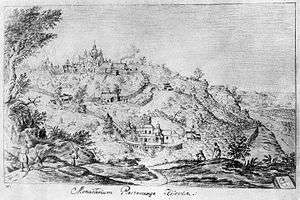Near Caves
The Near Caves or the Caves of Saint Anthony[1](Ukrainian: Ближні печери, Blyzhni pechery; Russian: Ближние пещеры, Blizhnie peschery) are historic caves and a network of tunnels of the medieval cave monastery of Kiev Pechersk Lavra in Kiev, the capital of Ukraine. The Near Caves have a total length of 383 metres and are 5 to 20 metres deep (see map).[2]

The Near Caves were founded when in 1057, Saint Varlaam was appointed as the first hegumen (abbot) of the Kyiv Pechersk Lavra by Saint Anthony. Monk Anthony withdrew himself from the monastery and later settled on a new hill, where he dug out a new underground cell, now called the Near Caves.[3]
Constructions
The Near Caves contain the underground Church of Saint Anthony, the Church of the Entry of the Mother of God into the Temple, and the Saint Varlaam Church. The caves also have a total of 79 surviving burials, among them being Nestor the Chronicler, the icon artists Alipy and Grigory, the doctor Agapit, the prince-ascetic Nikolai Sviatosha, the holy martyr Kuksha, as well as the remains of the epic hero Ilya Muromets. During the examination of the remains, it was established that Ilya Muromets had died from a stab wound.[2] According to a legend, a force of angels transported him from the place where he had died to the Lavra caverns.[2]
The Near Cave's main temple is the Church of the Elevation of the Cross (Khrestovozdvizhenska), which was constructed in the Ukrainian Baroque style from 1700-1704. The church's carved icons of 1769 have survived to this day. From the 19th century, the church served as a burial vault for the Kiev Metropolitens. The old refectory of the church is connected to the brother's cells, a Neoclassical style building with a four-column portico dating from the 1830s.
At the foot of the hill stands the Near Cave's belltower, which was designed and constructed by architect Stepan Kovnir in 1760. Also, the headstones of a number of well-known Kievans can be seen in front of the Khrestovozdvizhenska Church, namely, the headstone of the general-governor Aleksandr Bezak, which was designed by architect Mikhail Ikonnikov in 1860).[2]
Beneath the Near Caverns, two old draw-wells were recently discovered. According to the legend one of them was dug by Saint Anthony and the other by his best-known disciple, Theodosius of Kiev.[2] Beside the draw-wells, a chapel was built, now known as the Church of the Life-Giving Spring, built in honour of the Icon of the Mother God.
See also
Notes
- Another name can be Caves of Saint Anthony because the relics of Saint Anthony are buried here.
- Malikenaite, Ruta (2003). Guildebook: Touring Kyiv. Kiev: Baltia Druk. ISBN 978-966-96041-3-2.
- "Monastery of the Kiev Caves". orthodoxwiki.org. Retrieved November 23, 2006.
References
| Wikimedia Commons has media related to Near Caves, Kyiv-Pechersk Monastery. |
- Kolpakova, Valentyna. Підземна обитель. Ukraine-today (in Ukrainian). Archived from the original on March 7, 2002. Retrieved November 23, 2006.
- "Cave city". Interesniy Kiev (in Ukrainian). Retrieved November 23, 2006.
- "Near Caverns of the Lavra". National Kiev Pechersk Lavra Preserve (in Ukrainian). Archived from the original on July 18, 2011. Retrieved December 23, 2008.
- lavra.ua - Map of Kiev Pechersk Lavra near caverns, in Ukrainian
_Interiour.jpg)